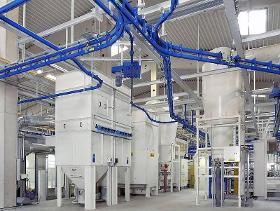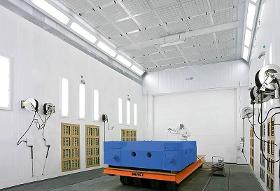- europages
- >
- COMPANIES - SUPPLIERS - SERVICE PROVIDERS
- >
- paint booth
Results for
Paint booth - Import export

NORD-LACKIERKABINE24 GMBH
Germany
Sandwich style EPS (Epispastic Polystyrene) 50 mm thickness. Door: 3 pieces of luxury front doors with 0.8mm thick colorful steel skin. Air Circulation System: 1X5.5kw intake fan. Belimo damper burner: Riello FS10 burner, 100000Kcal/h. Ceiling filters capture granules larger than 5 μm.
Request for a quote
RIPPERT ANLAGENTECHNIK GMBH & CO. KG
Germany
Separation of paint powder from powder coating booths. Options: Rippert powder filter This type of filter is particularly suitable for the separation of paint powder from powder coating booths and is also often used together with an upstream Rippert cyclone for powder recovery. Separation chamber with dust collecting container, filter cartridges, compressed air cleaning and sound-insulated fan are housed in a compact design. The filter cartridges are arranged vertically in order to ensure optimum cleaning behaviour and energy-efficient operation. The fan, which also comes from our own production, is characterised by smooth running and high efficiency. Standard advantages:
Request for a quote
RIPPERT ANLAGENTECHNIK GMBH & CO. KG
Germany
Up to three processes – cleaning, painting and drying in one booth. Multi-process booth Just one booth for cleaning, painting and drying (up to three processes). Dry paint filter and wet cleaning in one booth – that is actually a contradiction in itself. Thanks to the separate air guidance, the exhaust air is fed downwards through the grating when drying and laterally through the filter boxes when painting, so that very little moisture enters the dry filter and virtually no particles get into the cleaning water. In order to prevent the ingress of particles, the gratings can additionally be covered over during painting. Any paint that does get into the cleaning water is usually already dry, so that no dilution in the classic sense takes place; instead, it behaves like small, filterable plastic balls. Advantages:
Request for a quote
RIPPERT ANLAGENTECHNIK GMBH & CO. KG
Germany
Water-sprinkled spray walls and spray booths with automatic paint sludge filtration system In wet separation, the overspray meets the water film of the spray wall and is thereby bound in the water. The sludge formed by this is discharged using sludge filtration systems. Water-sprinkled spray walls The overspray is sucked in in the lower area of the vertical water drain surface and is bound in water when it meets the film of water. The paint mist is washed out further in the lower section of the washout tower using a vortex washing system with downstream baffle plate separator. In order to replace the water lost due to evaporation, it is recommended to fit an automatic water level controller. The entire quantity of water is fed to the automatic paint sludge filtration system via the disposal pump. A coagulant is added to the water by an automatic dosing unit, as a result of which the paint sludge in the circulating water is disbonded and can be separated more easily. The cleaning of the circulating water takes place in the separately arranged paint sludge filtration system. Depending on the paint system and plant version, the separation system is operated using a full or partial current method. Water-sprinkled spray walls/booths with underfloor paint mist extraction For the painting of large parts with a high paint throughput. The paint mist is sucked in under the grating cover. A substantial part of the overspray is already bound in the water by the constant sprinkling of the entire floor of the basin. The paint mist is washed out further in the lower section of the washout tower using a vortex washing system with downstream baffle plate separator. Optimum capture of the paint mist is guaranteed by the laminar air flow inside the booth. A further advantage over comparable systems is the low water basin height and the associated low foundation depth. The sludge formed by this is discharged using sludge filtration systems. Advantages
Request for a quote
RIPPERT ANLAGENTECHNIK GMBH & CO. KG
Germany
With high-quality filter tubes and PTFE diaphragms. Paint dust filters Wet painting also results in overspray. Overspray is the solid portion of the paint that is not taken up by the workpiece. According to the purpose of use, the overspray is moist and sticky immediately after release. It is captured by the exhaust air stream in the spray booth and fed to a filter. This can be, for example, a baffle plate filter, paper filter, fleece filter, glass fibre filter or also combinations of these. The adhesive effect causes the paint particles to adhere to the contact surfaces of the respective filter medium, as a result of which a good degree of separation is achieved. However, all these filters are storage filters, i.e. the filters clog up more and more during operation and cannot be regenerated. A filter exchange becomes necessary if the exhaust air rate of the spray booth falls below the minimum. This can be very time-consuming under certain circumstances and the work process must be interrupted in order to do it. To make things worse, not only must the filtered and bound paint residues be disposed of, but also the actual filter materials. Such tooling times are not justifiable for automatic, continuous or multi-layer painting processes. Continuous procedures such as automatically cleaned filters are likewise required for this. The humidity and the adhesiveness of the particles to be filtered are thereby the problem. In order to solve this problem, the paint particles should be relieved of their adhesive capability as far as possible whilst still inside the paint booth. Our patented ‘RTS-Rotation’ system is outstandingly well suited for this. The system is comprised of slowly rotating brush rollers, which take up the adhesive paint particles on the surface of the bristles and allow them to dry there. The bristles are automatically regenerated at pre-specified time intervals by combing devices that swing in at the rear of the brush rollers. The dislodged paint residues can then be removed and disposed of either manually during work breaks or automatically during operation. The degree of separation of this system is, however, insufficient to satisfy the environmental protection requirements concerning residual dust content in the exhaust air. A further filter stage is necessary for that. It must be assumed that the paint particles arriving here are to a certain extent still damp and sticky. For this we use special paint dust filters with high-quality filter tubes with PTFE diaphragms. If necessary, precoating agents (auxiliary dust) are used in order to neutralise the adhesive capability of the particles and to keep the dust layer on the filter elements permeable to air. The precoating agent is injected into the raw air pipe by means of special dosing units. The filter tubes are cleaned by means of compressed air impulse cleaning. The use of this technology requires special know-how. We have had the appropriate experience for almost ten years. The implemented plants have capacities ranging from 5,000 to 90,000 m³ /h. Because of the large number of different paint systems, individual experiments are usually necessary in our pilot plant in order to find the correct solution for the individual case.
Request for a quoteDo you sell or make similar products?
Sign up to europages and have your products listed

OLIGO LICHTTECHNIK GMBH SURFACE CONTROLS
Germany
The ARO PM is used for surfaces with high reflection and is optimally suited for use in paint booths without explosion protection requirements.
Request for a quoteResults for
Paint booth - Import exportNumber of results
7 ProductsCountries
Company type